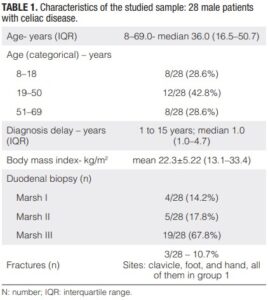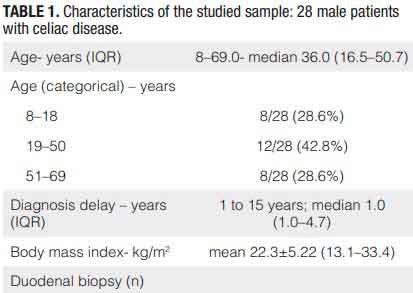HIGHLIGHTS
- Assessing BMD in CD patients is uncertain and studies in Brazil show lower BMD, especially in women, with limited data on men.
- Our results indicate a high prevalence of low BMD in males with CD, irrespective of their age, with older celiac men being particularly affected.
- CD patients benefit from BMD assessment at diagnosis for proper treatment and quality of life improvement.
ABSTRACT – Background –
Low bone mass density (BMD) is an extraintestinal finding in celiac disease (CD). This may result in bone fractures leading to loss in quality of life. Objective – To assess BMD in male CD patients at diagnosis according to the patient’s age. Methods – Descriptive retrospective carried out during the period between 2013 and 2023 in a single office that studied dual-energy X-ray absorptiometry (DXA) results in 28 male patients with a recent diagnosis of CD, divided into three groups: group 1 (age up to 18 years); group 2 (from 19 to 49 years of age) and group 3 (over 50 years of age). Were studied demographic and anthropometric parameters, time delay between symptoms onset and CD diagnosis and fracture occurrence. Results – Celiac patients studied had median age 36.0 years (IQR=16.5–50.7). Among them, 39.3% had osteopenia and 14.3% had osteoporosis. Only 36% of the sample had normal DXA values (group 1 with 37.5%; group 2 with 46% and group 3 with 14.2%). No pathological fracture was observed in this sample. CD diagnosis delay observed had median 1.0 year (IQR=1.0–4.7). When the number of individuals with normal and abnormal DXA results were compared, there was no difference in body mass index, time of diagnosis delay or Marsh classification (P=0.18). Conclusion – Male patients at the time of CD diagnosis showed a high prevalence of low BMD, which was particularly evident in individuals over 50 years of age. Keywords – Celiac disease; bone; males.
AUTORES
Lorete Maria da Silva KOTZE1, Thelma Larocca SKARE2, Luiz Roberto KOTZE1 and Renato NISIHARA2,3



